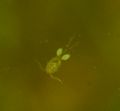Category:Live Food
![]() Please copy and paste ' [[Category:Live Food]] ' into the end of your article to include it in this category.
Please copy and paste ' [[Category:Live Food]] ' into the end of your article to include it in this category.
| Contents | Top · 0-9 · A B C D E F G H I J K L M N O P Q R S T U V W X Y Z |
|---|
This page lists the range of live food often fed to aquarium animals.
Live foods are foods that, as their name implies, are still alive. They are excellent for conditioning fish into breeding condition.
Some of the animals listed below are harder to get than others. Most are not for sale in your average aquarium shop and must be bought either from a local aquarium club, purchased online, or collected.
Once you get your live food animals, you do have the choice of trying to raise them for yourself or others in your neighbourhood. This is called culturing.
Contents
Brine Shrimp[edit]
Brine shrimp are probably the most popular live food and are often available from aquarium shops. They originate in extremely saline conditions, such as the Great Salt Lake of Utah. The male has two large claspers that are used to hang on to females when mating. They feed off of micro-organisms, but can be fed food commercially sold for them. Baby Brine Shrimp is newly hatched brine shrimp less than 24 hours old.
Daphnia[edit]
Daphnia also called water fleas are small freshwater aquatic crustaceans. They make excellent food for most fish.
Drosphila (Flies)[edit]
Drosophila are the larvae of the wingless or flightless fruit fly. Like the other live food, you can sometimes buy them from pet stores or you can culture them at home. More commonly sold by reptile shops.
Common house flies can be fed to your fish if they've not be caught by any chemical spray or sticky material.
More usual is to maintain a culture of wingless or flightless fruit flies. These 100% natural live food is eagerly taken by most top feeders. Typical species are Drosophila hydei (flightless) at 0.35cm (0.1") long or the smaller wingless Drosophila melanogaster at 0.15cm (0.1") long.
These flies need to be kept in a humid environment (>65%) and around 21.1-26.7°C (70-80°F) to remain active.
Feeder Fish[edit]
Feeder fish are low cost live fish, usually Goldfish, Rosy Reds or Guppies, fed to animals such as large predatory fish, frogs, turtles, and other predatory aquatic or semi-aquatic animals. If you must feed your pet feeder fish it's best to rear your own, store bought feeder fish are often badly bred and may be carrying diseases.
- Feeding live fish to another pet is illegal or disapproved of in some countries. Please check your country status.
Allowed or Approved of[edit]
United States of America, Canada
Not Allowed or Disapproved of[edit]
Great Britain, Ireland
Gammarus[edit]
Often called Scuds. these are a shrimp-like crustacean. It is an easy to culture live food that is an excellent size for many larger tropical fish. This crustacean reaches about 2.5cm (1") in length.
Vinegar Eels[edit]
These are nematodes, similar to a micro worm (they're not an eel) and are typically used as fry food, raised in extremely acidic conditions, usually a condition of 50% water and 50% apple cider vinegar. Feed them small bits of apple. Vinegar Eels are about 1cm (0.4") in length.
Vinegar eels live an average of 10 months, giving birth to as many as ~40 young every 8 to 10 days.
Vinegar eel are reported to live ~4 days in aquariums. Micro worms soon drown.
Worms[edit]
Blood Worm[edit]
Bloodworm is a common live larvae insect feed to fish and amphibians. Commonly sold in aquarium shops. Live blood worm can harbor diseases or parasites that can be passed on to your animal. These can be mostly found among worms in water. They have similar body structure like that of mosquito larvae and are bright red in colouration while rest of the worms are pale or darker in colour. Dried bloodworms are found in frozen forms in various aquaarium shops. After feeding a notable change of stool is observed in fishes stool which mostly feed on live worms.
Black Worms[edit]
Black Worms (often called California Blackworms®) somewhat resemble tubifex worms but they are generally healthier to feed to aquarium fish.
In cultured conditions grows up to 2.5-3.8cm (1-1.5") in length.
- Species - Lumbriculus variegatus
- Not generally available in the UK and EU for some reason.
Micro Worms[edit]
These are tiny white worms (nematodes) (Panagrellus redivivus) up to 3mm in length (smaller than baby Brine Shrimp).
Walter Worms[edit]
Similar but smaller than micro worms. But larger than Banana worms.
Banana Worms[edit]
Less than half the size of micro worms and smaller than Walter worms for smaller fry, these are in fact a nematode.
Grindal Worms[edit]
- Species - Enchytraeus buchholzi
These worms are smaller relatives of the White worm. They are white in colour and they reach up to 1-1.25cm (0.4-0.5") length. Being larger, they're often used to bring fish into breeding condition.
Cultivate exactly like White Worm. Grindal worms can tolerate a higher temperature than the white worms. Up to 20-22°C (68-71.6°F) and mature at ~16 days
- Grindal worms (bottom of web page link)
- PDF paper on the Influence of low soil moisture on enchytraeids
- How to Care for Your New Grindal Worms
- Preparing for your Grindal Worm Starter Culture
White Worms[edit]
Flora[edit]
Pages in category "Live Food"
The following 31 pages are in this category, out of 31 total.
C
D
K
S
Media in category "Live Food"
The following 8 files are in this category, out of 8 total.
- Blackworm3064es.jpg 79 KB
- Blackwormball3024es.jpg 260 KB
- Blackwormeat3010es.jpg 275 KB
- Blackworms3074es.jpg 226 KB
- Blackwormsfall3017es.jpg 154 KB
- Bloodworm1.jpg 12 KB
- Whiteworm1.jpg 144 KB
- Oczlik.jpg 81 KB








